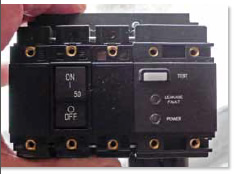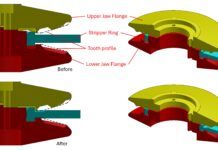
photo courtesy of Ed Sherman at ABYC
238
In the excellent article “DIY Survey Checklist for Used Boats,” PS suggests that AC outlets located in the galley and head (among other places) should be ground-fault protected. BoatUS requires this as well, for those of us insured with them, and the National Marine Manufacturers’ Association (NMMA) also requires it. I wish someone could explain to me why this is the case.
If you hold a shorted metal hair dryer and touch your metal bathroom faucet at home, you are in real trouble. The faucet is likely connected to a grounded metal pipe, an electrical circuit is competed, and you are in it.
On a boat, in almost all cases, the piping is either plastic hose or PVC piping, and if the current mysteriously got back to your water tank through this plastic pipe and non-salted water, chances are the tank is either fiberglass, or if it is metal, it is not grounded to the AC electrical system. If you have a shorted appliance, grab it with one hand, and your water faucet on your boat with the other, there is no circuit completed through the faucet, nor is a circuit completed through you.
I would propose that to the extent that is the case, GFCI (Ground Fault Circuit Interrupter) protection should be required in all AC outlets on a boat; or failing that, it should not be required at all, except where there is some obvious risk of coming in contact with a ground, such as an outlet on deck. To require otherwise is to have a requirement without a reason.
Michael Dietz
Via email
You make some valid points with regard to the plumbing on most recreational sailboats. However, plastic piping and hose is not necessarily the norm on commercial and military vessels, which also use American Boat and Yacht Council (ABYC, www.abycinc.org) standards as their guide for construction.
The BoatUS and NMMA requirements you mention are based on the guidelines set forth by the ABYC E-11 standard, which calls for 5-mA GFCI protection for galleys, heads, engine-room spaces, and on deck—all potentially wet areas of a boat. (The ABYC standard mirrors that of the National Electrical Code.)
The ABYC’s Ed Sherman explained the reasoning behind the standard: “Someone in bare feet, standing on a wet cockpit or cabin sole—even on their fiberglass boat, that may also be soaking wet during a rain storm—might indeed be connected to ground with less than pure fresh water as a conductor to salty sea water, which is an excellent conductor. At the cost of standard GFCI outlets, it’s all very cheap insurance.”
All that being said, we agree with your thinking that the standard should be an all-or-nothing requirement, and for safety’s sake, we side with the “all” thinking—so does the ABYC.
Beginning next summer, Sherman told Practical Sailor, the ABYC will require “whole boat” ground fault protection (at a 30 mA trip rate) on new boats via a device called an equipment leakage circuit interrupter (ELCI). The 5-mA GFCI devices will still be required as mentioned before.
Both the NMMA and BoatUS will be adopting this new “whole boat” protection standard, said Sherman, a PS contributor who has authored several books on marine electrical systems. His latest book, “Fundamentals of Marine Service Technology,” can be found at the ABYC online store.




































